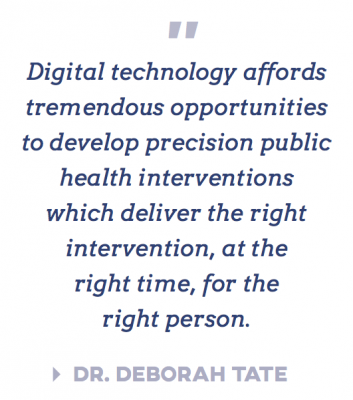How has digital technology changed public health?
October 15, 2017
Deborah F. Tate, PhD
Professor of health behavior and professor of nutrition
Director, UNC Weight Research Program
Director, Communication for Health Applications and Interventions (CHAI) Core
Most of our students can’t remember a time before digital technology. For perspective, consider that the iPhone celebrated its 10th birthday in 2017, Facebook is now firmly a teenager, Google turns 20 next year and the internet will be 50 in 2019. Digital technology has changed daily life dramatically, and clearly has made an impact on public health. Some of those changes have been good, and some, less so.
Q: What are some of the negatives of advances in technology?
A: We see so many benefits of technology in our lives, including progress on preventable causes of death such as tobacco, physical activity, diet and obesity. Not all technological advances are beneficial, though.
For example, research by Dr. Kurt Ribisl and colleagues at the Gillings School alerted us to the dangers of internet sales of tobacco products to minors and showed us the ways internet tobacco vendors escaped early taxation. Their research has helped to close these loopholes over the past decade or so, but this example illustrates how the opportunities offered by the internet are coupled with some public health perils.
In considering physical activity and obesity, digital technology presents more obvious challenges. It has been documented that the rise of computers and digital devices over the last couple decades has resulted in a decline of physical activity in the workplace. Although we don’t have studies to prove it yet, the omnipresence of digital technology also seems to be making it harder to avoid a sedentary lifestyle.
Still, there’s a big upside. Technology aids, such as smart watches, can be invaluable in providing cues to exercise, track and reinforce exercise behavior.
Q: How has your work used digital technologies to improve public health?
 A: Over the past 15 years, our work has focused upon digital solutions to obesity prevention and treatment. Some of our earliest studies used the internet to increase the potential reach of effective weight loss treatment to people who might not have access to a specialized, multidisciplinary treatment center. We are proud that our work provided needed evidence for online digital health counseling approaches to be considered a form of evidence-based weight loss.
A: Over the past 15 years, our work has focused upon digital solutions to obesity prevention and treatment. Some of our earliest studies used the internet to increase the potential reach of effective weight loss treatment to people who might not have access to a specialized, multidisciplinary treatment center. We are proud that our work provided needed evidence for online digital health counseling approaches to be considered a form of evidence-based weight loss.
We also have used digital technology for primary prevention. We’ve shown that a primarily digital approach can reduce weight gain in young adults over a period of three to five years. Young adults are at high risk for gaining weight during the many early adulthood transitions, and avoiding weight gain reduces their risk for getting cardiovascular disease, diabetes and cancer. Our recent work has shown that digital treatments are more effective than usual care in primary care settings – and also is more effective for lower-income Latina mothers in Women, Infant and Children (WIC) clinics. (See tinyurl.com/usda-wic.)
Q: Is this primarily an educational program delivered via cell phone?
A: No – and that’s an important point. Changing behavior is rarely about changing knowledge through education. Some populations truly lack knowledge about which foods are healthy or that physical activity is important – but that’s not the norm.
Digital interventions that work are grounded in behavioral science; delivered via a digital device; and provide behavioral skills training, monitoring, tailored feedback and support that help guide behavior change. That’s why many commercial apps are ineffective – they aren’t grounded in behavioral science and behavior-change techniques.
Q: How are digital technologies changing public health interventions?
A: Before digital technology was ubiquitous, public health interventions had to reach large numbers of people, and to do so they needed to be universal and less customized. Digital technology has changed that. We develop computer algorithms to deliver highly prescriptive, personalized interventions – ones that people can access on their smartphones – and we can change the recommendations and messages instantaneously to adapt to the user’s progress.
We know that not everyone responds to an intervention the same way, much the same as one blood-pressure medicine, or one dosage level, is not right for everyone. It has been hard to make public health interventions highly customized and yet still able to reach large populations. Wearable technology and smartphones with GPS now make it possible to develop algorithms that predict behavior better – and collect more data with less burden on the user.
In our Gillings Innovation Laboratory on Precision Public Health, along with Drs. Carmina Valle and Brooke Nezami, we have developed an app called “Nudge,” which employs this technology to deliver interventions “just in time,” along with guidance and a gentle push toward a healthier lifestyle.
The app functions much like a behavioral counselor, analyzing progress, making suggestions and providing praise for successes. It’s just much more scalable. This is a real opportunity for behavioral science and public health.
Carolina Public Health is a publication of the University of North Carolina at Chapel Hill Gillings School of Global Public Health. To view previous issues, please visit sph.unc.edu/cph.
